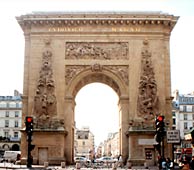At the end of the 18th and beginning of the 19th century numerous covered passages were created in Paris. The passages, mostly shopping arcades covered with glass roofs, were modern symbols of urban life and the place to shop in Paris. Many of these passages were beautifully decorated with mosaic floors, cast iron gates, marble pillars and ornate clocks.
At its peak during the mid 19th century, there was a network of more than 140 passages, many connected to each other. The pedestrianized passages, home to shops, restaurants and apartments, were very popular as they protected visitors from inclement weather and the often dirty and odorous streets. Their popularity soon started to decline due to competition from large department stores, and many were abandoned and started to fall in disrepair. Others were demolished during the redevelopment of Paris by baron Haussmann between 1852 and 1870 (see pictures below.)
At its peak during the mid 19th century, there was a network of more than 140 passages, many connected to each other. The pedestrianized passages, home to shops, restaurants and apartments, were very popular as they protected visitors from inclement weather and the often dirty and odorous streets. Their popularity soon started to decline due to competition from large department stores, and many were abandoned and started to fall in disrepair. Others were demolished during the redevelopment of Paris by baron Haussmann between 1852 and 1870 (see pictures below.)


During our Passages trek we stopped at the Porte de la Saint Denis. Some historical information incase you're interested:
History of the Porte Saint-Denis
The Saint-Denis arch was erected (1671-74) by Nicolas François Blondel, and paid for by the City of Paris. Small openings were cut into the sides to facilitate circulation, contrary to the architect's wishes.

On June 23, 1848, a bloody insurrection of disenchanted workers took place here, complete with the erection of barricades and capture of the national guard's post at the boulevard Bonne Nouvelle. In the ensuing firefight, over 30 insurgents were killed or wounded. The whole confligration was documented on June 25 by Fredrick Engels (the co-founder of Marxism), who subsequently published many accounts of the June Revolution in Neue Rheinische Zeitung.
The arch of the Porte Saint-Denis served as the inspiration for the more famous Arc de Triomphe de l'Etoile (completed in 1836), as well as for the Manhatten Bridge Arch in New York (designed by Carrere and Hastings, completed in 1909).
Historical factoid: Back in 1436, when Paris was still a fortified stronghold, the English — with the support of the Burgundians — had invaded and occupied an area of the city around the Porte Saint-Denis. However, their unwelcome presence was soon to be challenged: While King Charles VII was approaching Paris, its citizens began to revolt against their unwanted guests. Directed by Michel de Lailler and aided by the High Constables Richemont and Jean de Villiers d'Adam, a plan of attack was devised. Richemont, who was based in Saint Denis (outside the city limits), decided to enter Paris through the Porte Saint-Martin, while the English were expecting him at the Porte Saint-Denis. The English were soundly defeated, allowing King Charles VII to triumphantly enter the city on November 12, 1437.
One more factoid, the Musee Gormande du Chocolat is on Bonne Nouvelle. I thought you'd like to know.





No comments:
Post a Comment